We believe the arts matter. We view literary, visual, and performing arts as essential to all realms of society, including both education and the workforce. Creative and imaginative thinking, then, are skills that can (and must) be taught. Across the curriculum, the arts can operate as subjects, tools, settings, lenses, and ways of knowing. A number of professional resources are available to teachers interested in learning more about integrating the arts into their teaching, including offerings through institutions such as the Lincoln Center Institute, the Kennedy Center Alliance for Arts Education Network, and ArtsNow. As illustrated by the books below, children’s and young adult texts this year further demonstrate for readers the power, potential, and significance of the arts in the contemporary world from poetry, painting, architecture, and photography to music, theatre, and dance.
Ages 4-8
Golio, Gary. (2015). Bird and Diz. Illus. by Ed Young. Somerville, MA: Candlewick.
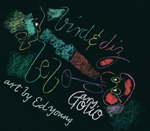 This nonfiction picture book is a playful and rhythmic celebration of jazz musicians Charlie “Bird” Parker and John “Dizzy” Gillespie, artists who, in the mid-1940s, helped develop bebop, a form of jazz that “relied on quick thinking and fast playing, complicated trails of notes, and rhythms that caught listeners by surprise and stuck in their heads.” Like saxophonist Parker and trumpeter Gillespie, author Golio and illustrator Young are each acclaimed artists in their own right. By bringing together their individual forms and styles of artistic expression, however, they contribute equally to the creation of a product with its unique meaning and synergy. Golio’s continuous narrative and Young’s pastel, gouache, and sumi ink illustrations interact similarly, mirroring the call and response, back-and-forth energy of bebop, and chasing each other across pages that invite readers to engage their senses even further by touching and feeling the heavy, matte cardstock paper. Even before readers open the book, they will find that the components of this book are held together by a clasp opposite the spine that joins the front cover to the back cover. Text features include an afterword that includes a brief biographical and contextual note, selected discography, and encouragement for readers to search online for videos of specific performances and to “pick up your crayons and draw!”
This nonfiction picture book is a playful and rhythmic celebration of jazz musicians Charlie “Bird” Parker and John “Dizzy” Gillespie, artists who, in the mid-1940s, helped develop bebop, a form of jazz that “relied on quick thinking and fast playing, complicated trails of notes, and rhythms that caught listeners by surprise and stuck in their heads.” Like saxophonist Parker and trumpeter Gillespie, author Golio and illustrator Young are each acclaimed artists in their own right. By bringing together their individual forms and styles of artistic expression, however, they contribute equally to the creation of a product with its unique meaning and synergy. Golio’s continuous narrative and Young’s pastel, gouache, and sumi ink illustrations interact similarly, mirroring the call and response, back-and-forth energy of bebop, and chasing each other across pages that invite readers to engage their senses even further by touching and feeling the heavy, matte cardstock paper. Even before readers open the book, they will find that the components of this book are held together by a clasp opposite the spine that joins the front cover to the back cover. Text features include an afterword that includes a brief biographical and contextual note, selected discography, and encouragement for readers to search online for videos of specific performances and to “pick up your crayons and draw!”
—TC
Myers, Christopher. (2015). My Pen. New York, NY: Disney-Hyperion.
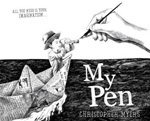 The power of a pen (and a little imagination and creativity) is the focus of the latest picture book by acclaimed author-illustrator Christopher Myers. The theme is made explicit to readers even before they open the book: The front dust jacket cover depicts a sea of black ink through which a young child sails in a newspaper boat. The child, who readers are led to conclude is Aurelio (a boy featured on a “1017-dollar bill” on the copyright page) gazes through a spyglass toward the hand of the illustrator, whose pen is poised above the page, mid-sketch. Text written in the upper left-hand side of the cover reads, “All you need is your imagination.” The sketchbook style is further illustrated on the end pages, filled with doodles and squiggles, and when one removes the dust jacket to find the front and back panels similarly covered in splotches of black ink. As the story opens, Aurelio remarks that when he when compares himself with rich and famous individuals, he sometimes feels small—until he remembers he has his pen. The book, illustrated with pen and ink and presented entirely in black and white, creates a sense of open-ended possibility. Throughout, both words and illustrations combine to demonstrate the many ways Aurelio’s pen has the power to create and change the world around him.
The power of a pen (and a little imagination and creativity) is the focus of the latest picture book by acclaimed author-illustrator Christopher Myers. The theme is made explicit to readers even before they open the book: The front dust jacket cover depicts a sea of black ink through which a young child sails in a newspaper boat. The child, who readers are led to conclude is Aurelio (a boy featured on a “1017-dollar bill” on the copyright page) gazes through a spyglass toward the hand of the illustrator, whose pen is poised above the page, mid-sketch. Text written in the upper left-hand side of the cover reads, “All you need is your imagination.” The sketchbook style is further illustrated on the end pages, filled with doodles and squiggles, and when one removes the dust jacket to find the front and back panels similarly covered in splotches of black ink. As the story opens, Aurelio remarks that when he when compares himself with rich and famous individuals, he sometimes feels small—until he remembers he has his pen. The book, illustrated with pen and ink and presented entirely in black and white, creates a sense of open-ended possibility. Throughout, both words and illustrations combine to demonstrate the many ways Aurelio’s pen has the power to create and change the world around him.
—TC
Ages 9-11
Holt, Kimberly Willis. (2015). Dear Hank Williams. New York, NY: Henry Holt.
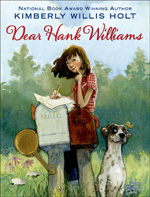 Set in 1948, this epistolary novel by National Book Award–winning author Kimberly Willis Holt tells the story of 11-year-old Tate, who responds to her teacher’s assignment to find a pen pal in Japan by deciding instead to correspond with Hank Williams, an up-and-coming country music singer whose radio performances Tate listens to weekly with her great-aunt and great-uncle. In her letters to Williams, Tate describes her family, claiming initially that her mother is an actress and her father is a renowned photographer (later revealing that this is not true). Her letters often focus on her ability to sing, a talent she states she shares with her mother, and that she nurtures through daily practice in anticipation of entering a singing contest. As her letters progress, Tate reveals more of the reality and truth of her life experiences (her mother, for example, is in jail); although the stories are often tragic, the love of her family and her passion for music help Tate persevere. Although the only response Tate receives from Williams comes in the form of a few photographs, Tate continues to send him letters, as writing to the country music star—in addition to listening to his music—serves a therapeutic function for her. Through Tate’s letters, readers learn about historical events of the era (including anti-Japanese and anti-Communist sentiments following the end of World War II), as well as the power and value of music.
Set in 1948, this epistolary novel by National Book Award–winning author Kimberly Willis Holt tells the story of 11-year-old Tate, who responds to her teacher’s assignment to find a pen pal in Japan by deciding instead to correspond with Hank Williams, an up-and-coming country music singer whose radio performances Tate listens to weekly with her great-aunt and great-uncle. In her letters to Williams, Tate describes her family, claiming initially that her mother is an actress and her father is a renowned photographer (later revealing that this is not true). Her letters often focus on her ability to sing, a talent she states she shares with her mother, and that she nurtures through daily practice in anticipation of entering a singing contest. As her letters progress, Tate reveals more of the reality and truth of her life experiences (her mother, for example, is in jail); although the stories are often tragic, the love of her family and her passion for music help Tate persevere. Although the only response Tate receives from Williams comes in the form of a few photographs, Tate continues to send him letters, as writing to the country music star—in addition to listening to his music—serves a therapeutic function for her. Through Tate’s letters, readers learn about historical events of the era (including anti-Japanese and anti-Communist sentiments following the end of World War II), as well as the power and value of music.
—MG
Altebrando, Tara. (2015). My Life in Dioramas. Illus. by T.L. Bonaddio. Philadelphia, PA: Running Press.
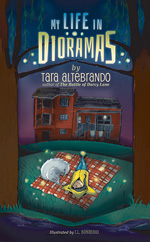 Twelve-year-old Kate lives with her parents, both musicians, in a house known by those living in their town as “Big Red.” As a result of financial difficulties, her parents decide they have to sell the house and move the family into the home of Kate’s grandparents. Kate is resistant to this change, hoping instead to stay at her current school with her friends and where she will also have the opportunity to participate in a dance competition. When the house is put on the market, Kate does anything she can to keep the realtor from finding a buyer—making plans that include not only annoying noises but also “fecal matter.” Kate begins making shoebox dioramas of each room in her home, both as part of a school assignment and later as a way to express her feelings. From the dioramas to her interest in dance and her musician parents, Kate’s life is infused with the arts, which are a powerful outlet for the protagonist. Although some of the characters feel underdeveloped and the storyline is somewhat predictable, readers may identify with many of issues Kate must confront and appreciate the broad range of artistic forms described in this novel. Final artwork not seen/review based upon advance uncorrected proof.
Twelve-year-old Kate lives with her parents, both musicians, in a house known by those living in their town as “Big Red.” As a result of financial difficulties, her parents decide they have to sell the house and move the family into the home of Kate’s grandparents. Kate is resistant to this change, hoping instead to stay at her current school with her friends and where she will also have the opportunity to participate in a dance competition. When the house is put on the market, Kate does anything she can to keep the realtor from finding a buyer—making plans that include not only annoying noises but also “fecal matter.” Kate begins making shoebox dioramas of each room in her home, both as part of a school assignment and later as a way to express her feelings. From the dioramas to her interest in dance and her musician parents, Kate’s life is infused with the arts, which are a powerful outlet for the protagonist. Although some of the characters feel underdeveloped and the storyline is somewhat predictable, readers may identify with many of issues Kate must confront and appreciate the broad range of artistic forms described in this novel. Final artwork not seen/review based upon advance uncorrected proof.
—MG
Keenan-Bolger, Andrew, and Kate Wetherhead. (2015). Jack & Louisa: Act 1. New York, NY: Grosset & Dunlap.
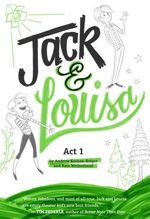 Jack & Louisa: Act 1 is the debut novel of musical theater performers Andrew Keenan-Bolger and Kate Wetherhead. The first in a series of middle grades novels, the authors drew heavily upon their own childhoods and experiences in musical theater to write the story of 12-year-old Jack Goodrich, a boy with extensive Broadway experience who moves with his parents from New York City to Shaker Heights, Ohio. Jack, whose changing voice was the impetus for his family’s departure from New York, intends to leave his life as a performer behind him, a plan challenged by Louisa (Jack’s new neighbor and a self-proclaimed “Musical Theater Nerd”). Keenan-Bolger and Wetherhead took turns writing chapters, and the book alternates between Jack’s and Louisa’s perspectives. As one may infer from the title, Jack & Louisa: Act 1 reflects its creators’ inexperience as writers of children’s literature and, ultimately, the storyline is predictable, the dilemmas feel contrived, and the outcomes of the narrative are obvious. Although teachers, librarians, and children’s literature researchers may have a tepid response to the book, young readers looking for a book saturated with musical theater references (most prominently, Sondheim’s Into the Woods, but also shows ranging from Guys and Dolls and Anything Goes to The Book of Mormon) may find the book an entertaining read.
Jack & Louisa: Act 1 is the debut novel of musical theater performers Andrew Keenan-Bolger and Kate Wetherhead. The first in a series of middle grades novels, the authors drew heavily upon their own childhoods and experiences in musical theater to write the story of 12-year-old Jack Goodrich, a boy with extensive Broadway experience who moves with his parents from New York City to Shaker Heights, Ohio. Jack, whose changing voice was the impetus for his family’s departure from New York, intends to leave his life as a performer behind him, a plan challenged by Louisa (Jack’s new neighbor and a self-proclaimed “Musical Theater Nerd”). Keenan-Bolger and Wetherhead took turns writing chapters, and the book alternates between Jack’s and Louisa’s perspectives. As one may infer from the title, Jack & Louisa: Act 1 reflects its creators’ inexperience as writers of children’s literature and, ultimately, the storyline is predictable, the dilemmas feel contrived, and the outcomes of the narrative are obvious. Although teachers, librarians, and children’s literature researchers may have a tepid response to the book, young readers looking for a book saturated with musical theater references (most prominently, Sondheim’s Into the Woods, but also shows ranging from Guys and Dolls and Anything Goes to The Book of Mormon) may find the book an entertaining read.
—TC
Ages 12-14
Balliett, Blue. (2015). Pieces and Players. Illus. by Brett Helquist. New York, NY: Scholastic.
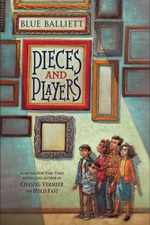 When 13 pieces of art are stolen from a Chicago museum, five children bring their own special talents to the task of locating the missing artwork. With the aid of their former teacher, Ms. Hussey, the children piece together clues, make connections among their findings, follow hints for locating the missing works of art, and even talki with a ghost while they weave their way through the mysterious art caper. Despite questions the children have about the trustworthiness of some individuals with whom they interact (including Mrs. Sharpe, a suspicious-acting museum trustee) and obstacles they encounter (such as resistance from the police), the children persevere and ultimately recover the missing artwork. Fans of Balliett’s previous work are certain to be drawn in by this mystery, where seemingly random clues come together as readers continue toward the surprising conclusion.
When 13 pieces of art are stolen from a Chicago museum, five children bring their own special talents to the task of locating the missing artwork. With the aid of their former teacher, Ms. Hussey, the children piece together clues, make connections among their findings, follow hints for locating the missing works of art, and even talki with a ghost while they weave their way through the mysterious art caper. Despite questions the children have about the trustworthiness of some individuals with whom they interact (including Mrs. Sharpe, a suspicious-acting museum trustee) and obstacles they encounter (such as resistance from the police), the children persevere and ultimately recover the missing artwork. Fans of Balliett’s previous work are certain to be drawn in by this mystery, where seemingly random clues come together as readers continue toward the surprising conclusion.
—MG
Ages 15+
Wilke, Daria. (2015). Playing a Part. Trans. By Marian Schwartz. New York, NY: Arthur A. Levine.
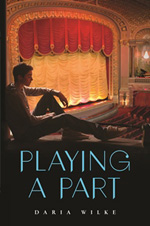 Translated from the original Russian by Marian Schwartz, this novel by Daria Wilke is notable, in part, because international translations are somewhat of an anomaly in young adult literature. Further, the novel emerged in the midst of the enactment of homophobic laws in Russia. This brief and contemplative Bildungsroman centers on Grisha, a teenage boy growing up in a puppet theater in Moscow. At the start of the novel, Grisha struggles with the impending departure of Sam, an actor he admires, who is leaving as a result of the homophobia he experiences in Russia. As the story progresses, Grisha faces further difficulties, such as the replacement of a bellowed puppet master and his best friend Sashok’s upcoming heart surgery. The novel reads like a slice-of-life story, with flashbacks interspersed throughout its primary narrative and will be primarily of interest for the reasons listed at the opening of this review. Removed from the social and political context in which Wilke wrote the novel, however, Playing a Part is similar in vein to the didactic, “affirmative” American young adult problem novels depicting gay males in the 1990s and early 2000s.
Translated from the original Russian by Marian Schwartz, this novel by Daria Wilke is notable, in part, because international translations are somewhat of an anomaly in young adult literature. Further, the novel emerged in the midst of the enactment of homophobic laws in Russia. This brief and contemplative Bildungsroman centers on Grisha, a teenage boy growing up in a puppet theater in Moscow. At the start of the novel, Grisha struggles with the impending departure of Sam, an actor he admires, who is leaving as a result of the homophobia he experiences in Russia. As the story progresses, Grisha faces further difficulties, such as the replacement of a bellowed puppet master and his best friend Sashok’s upcoming heart surgery. The novel reads like a slice-of-life story, with flashbacks interspersed throughout its primary narrative and will be primarily of interest for the reasons listed at the opening of this review. Removed from the social and political context in which Wilke wrote the novel, however, Playing a Part is similar in vein to the didactic, “affirmative” American young adult problem novels depicting gay males in the 1990s and early 2000s.
—TC
Thomas Crisp is an assistant professor in the Department of Early Childhood and Elementary Education, where he teaches courses in children’s and young adult literature and literacy. Mehmet Gultekin is currently a PhD student in the Department of Early Childhood and Elementary Education, where he also works as a research assistant. They are both at Georgia State University.
The review contributions are provided by members of the International Literacy Association’s Children’s Literature and Reading Special Interest Group.